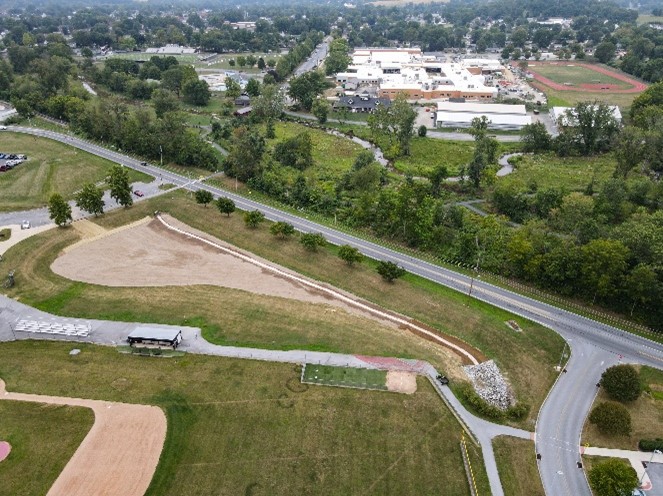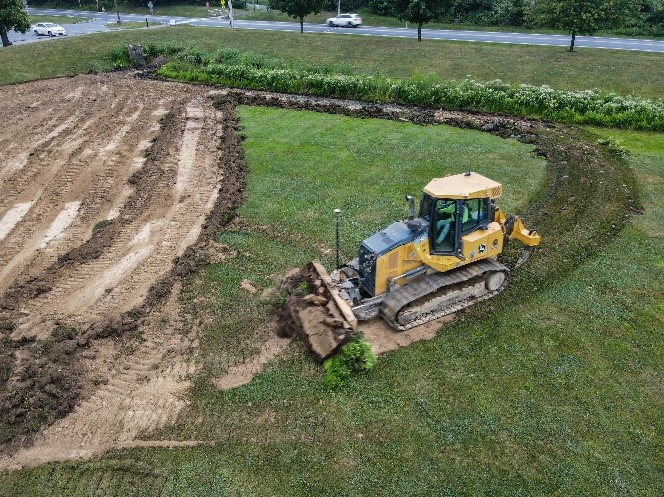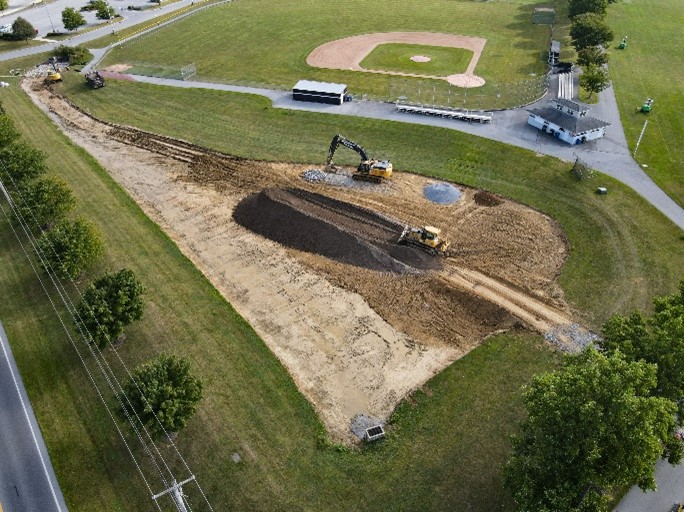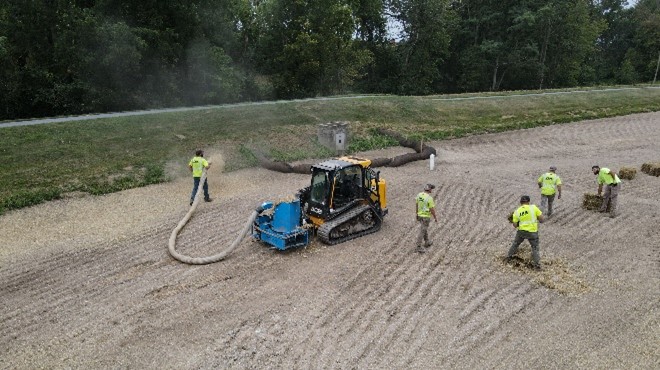Why Stormwater Basin Restorations Are Essential

Flooded roadways. Polluted runoff diverted into the water supply. Erosion eating away at stream banks.
All of these are consequences of unoptimized stormwater systems. As the built environment increases the amount of impervious surfaces in our communities, we need to enhance our stormwater management.
In the late summer of 2023, Penn Township in Lancaster County, PA did just that.
Over the course of a few weeks, Horst Excavating’s Small Projects Team transformed two of their existing water basins. Through regrading, improved drainage, and enhanced plantings, these stormwater management systems can now absorb more water and slowly divert cleaner runoff into the nearby streams.
In this blog, we’ll address the motivation and benefits of a project like this, as well as the steps on how to achieve it.
Benefits of Runoff Basin Restorations

Basins collect rainwater to store or divert to waterways. But over time, their effectiveness can be diminished. As sediment builds up in the basin, its holding volume decreases. Additionally, the turf grasses traditionally used to line many basins have shallow roots and do a poor job absorbing water. These issues can lead to flooding and worsen the pollution and bank erosion of our waterways.
To help solve these challenges, property owners and municipalities are enhancing their stormwater systems. The overall goal of most basin retrofits is to slow the flow and improve the filtration of the water moving out of the basin.
Proper stormwater management is an essential step in maintaining a clean water supply and keeping our ecosystems healthy. Local regulations may change, and retrofits of basins may be required to meet new benchmarks.
Additionally, basins in need of improvement may contribute to frequent and damaging flooding. This not only threatens the property the basin is located on, but it also impacts neighbors’ property and nearby infrastructure and roads. Damage from flooding caused by an underperforming basin could end up costing more than a basin retrofit.
Additionally, basins can be designed in a way that reduces maintenance costs. Depending on its design and the plantings installed, your organization could save money on mowing and land care man hours, as well as wear-and-tear on equipment and fuel costs.
 Steps to Basin Retrofits
Steps to Basin Retrofits
The steps of restoring or retrofitting your basin will vary depending on the size and scale of the changes you’re looking for. Services can range from simple landscaping retrofits to more complex engineering changes that alter the basin’s holding volume.
1. Plan & Design
To kick things off, you want to assemble a team of qualified professionals who have the experience needed to optimize your basin. But what types of firms should you be reaching out to?
This will depend on the scope of your retrofit and the resources you have available but can include civil, geotechnical, and environmental engineers, landscape architects, and other specialists and consultants, such as hydrology consultants, environmental consultants, and surveyors. An excavator or sitework specialist (like Horst Excavating) can also play a critical role in the planning and designing stage of a project, offering real-world insight and expertise.
You should also consider your project’s budget during this stage. How much cash, if any, is available, and are there any grants or financing options available? While cost will vary with how extensive the retrofit is, it may be possible to improve water quality and reduce flooding without spending a huge sum.
If you opt for a simpler retrofit that involves replacing existing vegetation with better-absorbing options, you likely won’t need to involve engineers to calculate holding volume changes, nor will you have to acquire permits. More involved retrofits that require changes to the hydrology of the basin will require more enhanced design and permitting, which in turn will cost more.
 2. Clearing, Grading, & Drainage
2. Clearing, Grading, & Drainage
Next, your construction team will fire up the equipment and mobilize, working to clear the way for the planned improvements. In some cases, this will require the excavating team to skim the top of the surface, removing grass and other vegetation. In other cases, they’ll cut into the earth to reconfigure the profile of the basin.
With strategic grading, they can create longer flow paths and berms, reduce steep slopes, or increase the holding volume by excavating a deeper or wider basin.
Improving drainage can include installing new or enhancing the existing drainage system. Adding or extending drainage pipes can help improve the flow of water out of the basin. This system will divert water into nearby streams, lakes, rivers, or other bodies of water once the ground within the basin becomes saturated.
 3. Plantings & Proper Maintenance
3. Plantings & Proper Maintenance
Most modern water basin retrofits utilize vegetation chosen specifically to absorb and filter out water. Instead of standard turf grass that requires regular maintenance like mowing, this naturalized and diverse mix of plants may work best for your new basin if they’re left to grow and only mowed occasionally. The frequency will vary depending on the seed mix you choose.
You may also need to regularly weed and check for unwanted invasive species, especially in the beginning as the new plants get established. Non-native plants can choke the growth of the plants chosen specifically for the basin, which can lead to a reduction in the efficiency of the basin.
Finding the Right Team
Retrofitting or restoring your stormwater basins can be an essential step in ensuring your property is functioning and properly maintained. Finding the right team to help you complete this project is just as important.
At Horst Excavating, we have teams and solutions to suit projects of just about any size. From quick and affordable stormwater improvements to the creation of new, stormwater management systems for large properties.
Contact us today to talk about your project.
Posted September 11, 2023

 Steps to Basin Retrofits
Steps to Basin Retrofits 2. Clearing, Grading, & Drainage
2. Clearing, Grading, & Drainage 3. Plantings & Proper Maintenance
3. Plantings & Proper Maintenance